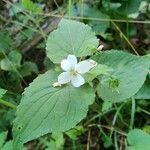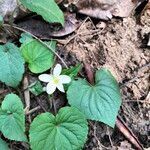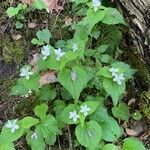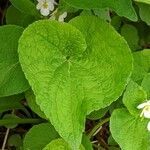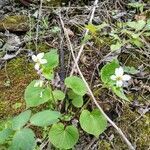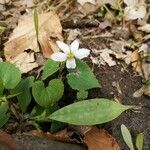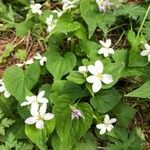Plants perennial, caulescent, not stoloniferous, 3–46(–60) cm, with branching rhizomes forming colonies or not. Stems 1–3(4), usually erect to ascending, glabrous or puberulent, from fleshy or subligneous rhizome. Leaves basal and cauline; basal: 1–5; stipules ± oblong, ovate, or lanceolate, margins entire, sometimes glandular, apex acuminate to cuspidate; petiole 1.1–23 cm, glabrous or puberulent; blade ovate to broadly ovate or ovate-reniform, 0.7–12.4 × 0.9–11.1(–12.3) cm, base cordate, subcordate, or truncate, margins crenate, crenulate, or serrulate, ciliate (sometimes only on proximal 1/2) or eciliate, apex acute to acuminate, surfaces glabrous or puberulent (often only on veins); cauline similar to basal except: stipules also deltate, margins also erose or laciniate, apex acute, long-acuminate to cuspidate, or ± truncate, occasionally 2-or 3-fid; petiole 0.1–6.9(–15.2) cm; blade ovate to deltate, 1.2–7.7 × 0.8–7.8 cm, base cordate to truncate, margins crenate or crenulate to ± serrulate. Peduncles 1–6.1 cm, glabrate to puberulent, sometimes glabrous below bracteoles. Flowers: sepals lanceolate, margins usually eciliate, auricles 0.5–1.3 mm; petals white adaxially, upper 2 and lower 3 tinged soft reddish violet abaxially, rarely white on both surfaces, all petals usually with yellow patch basally, lower 3 usually purple-veined, lateral 2 bearded, lowest 5.5–20 mm, spur white, gibbous, 1–2 mm; style head bearded; cleistogamous flowers axillary or absent. Capsules ovoid to ellipsoid, 2.5–10 mm, sometimes muriculate, glabrous or puberulent. Seeds brown to dark brown or purplish black, 1.5–2.5 mm.
More
Glabrous or minutely to less often evidently hairy; stems 2–4 dm; basal lvs well developed, long-petioled, ± cordate at base, often relatively wider than the cauline ones; cauline lvs several, the lower widely spaced, the upper larger and more crowded, mostly cordate and 5–10 cm; stipules lance-acuminate, entire, whitish and subscarious; fls slender-pedicellate from the upper axils; pet white inside, with a yellow base, the 3 lower ones with purplish lines toward the base, the lateral ones bearded, all (but especially the upper pair) ± purplish-tinted on the outside and sometimes less strongly so on the inside; style bearded at the capitate summit; frs ellipsoid-globose; 2n=24. Moist woods, Nf. to Alas. and B.C., Ala., Ark., and Ariz. Mostly Apr.–July. Most of our plants belong to var. canadensis, widespread in e. U.S. and adj. Can., with a short, stout rhizome, short or no pubescence, and lvs usually longer than wide. The chiefly western var. rugulosa (Greene) C. L. Hitchc., colonial by long stolons or superficial rhizomes, usually evidently hairy, and with the lvs often wider than long, extends e. to Wis. and Io. and is disjunct in the mts. of sw. Va., nw. N.C., and e. Tenn. (V. rugulosa)
A small plant. It grows 10-40 cm tall. The stems are slender. These have several heart shaped leaves. The flowers are white to violet and yellow at the base. There are purple lines. The seed pods open suddenly with a twist.
Riparian, coniferous or aspen forests, deciduous and mixed forests, cove hardwoods, northern hardwood forests, moist, shaded slopes, sandy, rich, or rocky soil, talus slopes, road cuts; at elevations from 50-3,600 metres.
More
It is a temperate plant. It grows in groups in rich, moist forests. It suits hardiness zone 4.
